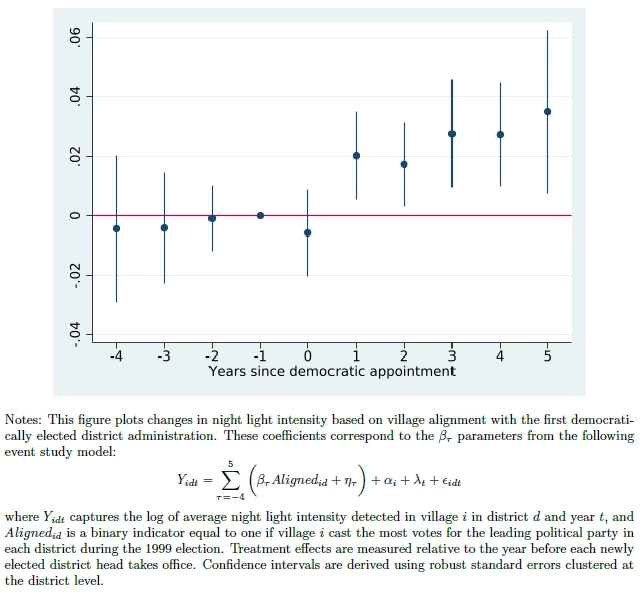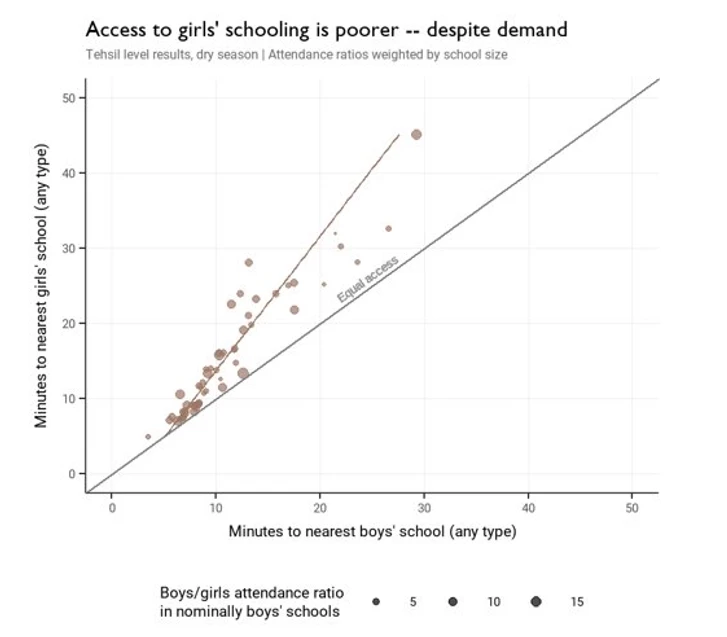This is the 16th in this year’s series of posts by PhD students on the job market.
Democratization is supposed to produce responsive leaders. By empowering previously disenfranchised citizens, democratization may incentivize the allocation of state resources across broader coalitions of voters. But at the point of democratization, politician incentives to appease new voters may depend on the strength of baseline institutions (Acemoglu and Robinson, 2008). Given the global push towards democratization in recent decades, this relationship between elected leaders and political responsiveness could have profound repercussions for the allocation of state resources around the world. This raises the question: does the appointment of democratically elected leaders generate meaningful responses to new voting coalitions?
In my job market paper, I study the nature of political responsiveness following Indonesia’s democratization. I leverage the staggered rollout of elected district heads following the country’s first democratic election, using an event study design to estimate changes in village outcomes based on support for leading political parties in each district. My empirical approach allows me to compare outcomes before and after an elected leader takes office, at the same point in time, within the same broader institutional context. Baseline estimates use nighttime light intensity to capture annual shifts in economic activity across villages. Additional analyses use village census data to test whether changes in political responsiveness result in meaningful improvements in public goods provision at the village level.
My analysis benefits from several additional features of the Indonesian context. First, granular data on development and voting outcomes allow me to explicitly measure changes in outcomes across voting coalitions, rather than simple levels of aggregate spending. Second, by comparing outcomes across local governments, I can test for heterogeneity in responsiveness based on local institutions, without worrying that (district) institutional differences will be endogenous to (national) democratic reforms. Third, by exploiting the independent staggering of village head elections, I can additionally study the targeting of favors towards local officials once elected district administrations take office. Together, these institutional features allow to study the mediating effects of local institutions and local officials on political responsiveness following democratization.
How do elected politicians respond to new voters following democratization?
I find that elected leaders allocate benefits based on the strength of political support across coalitions of new voters. Figure 1 shows results from my baseline event study model. When an elected district head takes office, night light growth is 2.37 percentage points greater across villages that cast the most votes for the leading political party. Additional specifications find that effects are stronger where villages provide greater support for leading parties, and where aligned politicians receive a larger share of district votes. Estimated effects are meaningful in size: empirical studies have found political favors to increase night light intensity by around four percentage points across a range of settings.
Figure 1: Political Alignment and Night Light Intensity

Results suggest that newly enfranchised voters are immediately able to demand benefits from elected administrations. Theory holds that these dynamics should be more pronounced where voters have greater information available on politician behavior. To test this hypothesis, I re-run baseline specifications, allowing for heterogeneity by media access across districts. I find that results are entirely driven by districts with greater access to media sources in the baseline, supporting the view that democracy is more impactful when institutions increase voter scrutiny of politicians prior to reelection.
Does political responsiveness translate into meaningful public investment?
Results based on night light intensity could be driven by excludable favors targeted at political supporters, or by the broader provision of public goods within politically aligned regions. To test this further, I measure changes in public infrastructure using data from PODES, Indonesia’s regular census of villages. Results are shown in Table 1 below. I find no improvement in public goods provision across aligned villages, and (almost) no increase in public goods more broadly under the first wave of elected district heads. Taken together, evidence suggests that elected leaders reward political supporters with private benefits rather than increasing broader investment in public goods. Evidence therefore appears more consistent with a shift towards new systems of clientelism under elected politicians, where transactional interactions with voters are prioritized at the expense of more general development efforts.
Table 1: The Effect of Political Alignment on Public Goods Provision

Additional findings support the interpretation that baseline results are driven by political favoritism, rather than broader economic growth under elected politicians. In particular, estimated alignment effects are stable across a range of specifications that include dynamic, flexible time trends based on village characteristics (local infrastructure, industry, etc.) that may independently dictate growth under elected leaders.
Favoritism and Local Politicians
If elected politicians target state resources to gain political advantage, they may also work to establish networks of loyal local officials. In my final set of analyses, I examine this behavior across Indonesian village heads, who often exchanged personal benefits for political loyalty under the prior autocratic regime (Evers, 2000). I exploit the fact that village head elections are independently staggered over time, finding that relative growth in night light intensity within aligned villages is greater during village head election years (see Figure 2). I interpret this result as a form of favoritism directed at village politicians to preserve local political advantages. Consistent with this interpretation, I find no evidence for corresponding election year effects within unaligned villages. These findings support theory from Acemoglu, Ticchi and Vindigni (2011), who argue that following democratization, politicians may forego more substantive investments in development if winning coalitions can be maintained via new systems of transactional politics.
Figure 2: Change in Village Election Cycles, Post-Democratization –
Aligned vs. Unaligned Villages

Policy Implications
My results provide a unique perspective on the effects of democratization, estimating the targeting of benefits under elected leaders, while holding constant other institutional shifts involved in the democratization process. Findings suggest that while elected leaders respond to new voting constituencies, this initial responsiveness may not yield meaningful development efforts, and may vary substantially based on local institutions and local officials. In light of these findings, policies that strengthen the relative power of voters – such as broadening media access or improving voting technology – may be particularly valuable at the point of democratization, shaping not just the immediate allocation of state resources, but also the balance of political power across constituencies moving forward.
Curtis Morrill is a PhD candidate in the Department of Agricultural and Resource Economics at the University of California, Davis. His work studies the impacts of political accountability and decentralization on local development outcomes, networks of patronage, and the management of natural resources. Learn more about his research at: https://www.curtismorrill.com.


Join the Conversation